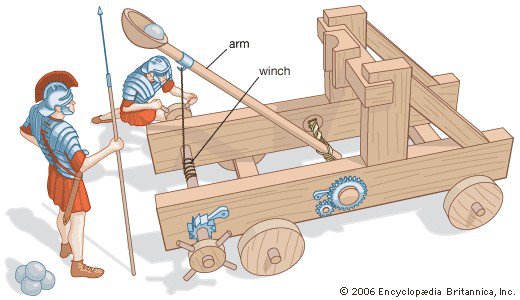Make your own Roman catapult
Catapults used by the Romans

In this activity, your class will learn about the different catapults that the Romans used before designing and making their own Roman style catapult.
Download: Catapults PDF resource (1.4 MB)
The Romans did not invent the catapult, but they improved the Greeks design which was created in the fourth century BC. They made changes to the materials used and made design tweaks which allowed them to achieve a better range and accuracy than before.
The Romans had a number of different catapults that they used in different situations. The three main ones were the Scorpion, the Ballista and the Onager.
The Scorpion
The scorpion was a smaller catapult-type weapon, which was operated by only one man.
The scorpion typically looked like a cross-bow in design and had a wooden or metal frame consisting of a stock, winch and base. Two coils of rope made from hair or animal tendons encased in a metal-plated box under tension, acted as springs. When released, they gave the arm of the device greater force.
It was used to kill and injure the enemy rather than damage buildings.
The Ballista
The ballista looked and worked like the scorpion but it was bigger and much more powerful.
It could fire a 60lb (27kg) stone forward or a 3ft bolt (100m) and was capable of hitting a wall up to 550 yards (503m) away. This was far outside the range of enemy bowmen who could only fire the arrows to a distance of about 110 yards (100m). It therefore allowed the soldiers to set it up away from the enemy. It could also move with speed and was enabled to hit its target at speeds of 115mph and it was therefore likely to kill someone instantly or at least seriously injure them.
The Onager
The onager was a base frame with wheels at each corner. In the middle was a vertical framework with a crossbar at the top. At the bottom was a long beam of wood which was attached at the lower end to a very tightly twisted plaited rope. This was to give the spring action to the weapon. At the other end of the arm was a large spoon like container that held the missile, which was normally filled with a heavy rock or masses of stones. The rocks could weigh up to 150lbs (68kg) and were used to smash through walls, ramparts and turrets.
Create your own catapult
Create your own catapult
Why not have a go at creating and experimenting with your own catapult like the Romans did?
Below are a couple of different ways to make catapults.
Easy catapult
You will need:
- A cardboard tube
- Two elastic bands (or hair bobbles work too)
- A spoon
- Something small and soft to fire (a pom pom, a cotton wool ball etc.)
- Optional: Some sticky tape to secure your catapult down
Step 1
Secure your spoon to the cardboard tube with two elastic bands (or hair bobbles) - keep winding them until the spoon is on tightly.
Step 2
Hold the tub firmly with one hand (or use sticky tape to secure your catapult to a table). Put something to fire on the spoon and pull the spoon back, aim, and fire away.
Please be careful when firing your catapult to avoid people’s eyes and injuring others.
Catapult made with lolly sticks
You will need:
- 9 lolly sticks
- 3 elastic bands
- A bottle top and double-sided tape or a spoon with two more elastic bands
- Something small to fire (a pom pom, a polystyrene ball, a cotton wool ball etc
Step 1
Make a stack of 7 lolly sticks and use two elastic bands to tie them tightly together at both ends.
Step 2
Make a stack of 2 lolly sticks and use an elastic band to tie them together at one end only.
Step 3
Pull the two lolly sticks apart and wedge the stack of 7 lolly sticks between them.
Step 4
Add double-sided tape to the bottom of your bottle top and stick it to the upper lolly stick.
Alternatively use two elastic bands and secure a spoon to the upper lolly stick.
Step 5
Place your pom pom, ball or cotton wool ball onto the spoon or bottle top. Hold the catapult with one hand and use the other hand to push down on the spoon or bottle top and see how far your ball goes.
Please be careful when firing your catapult to avoid people’s eyes and injuring others.
Challenge yourself
Challenge yourself
Why not have a go at making a catapult out of other materials such as Lego.
You could even experiment by seeing which materials go the furthest when you throw them from your catapult (e.g. pom pom balls, rolled up kitchen foil, polystyrene balls, cotton wool balls etc).




